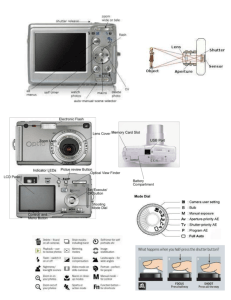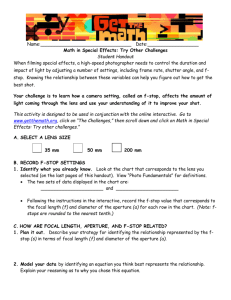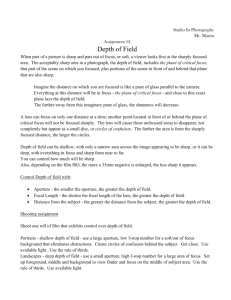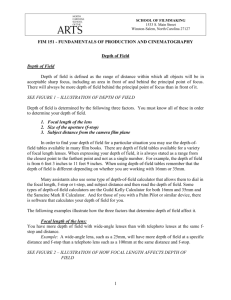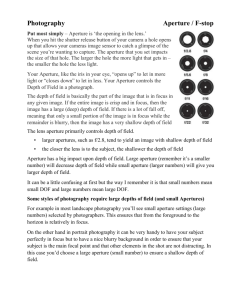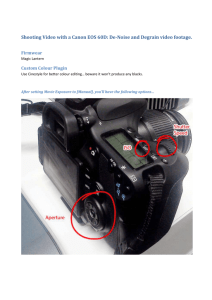DOC - Thirteen
advertisement
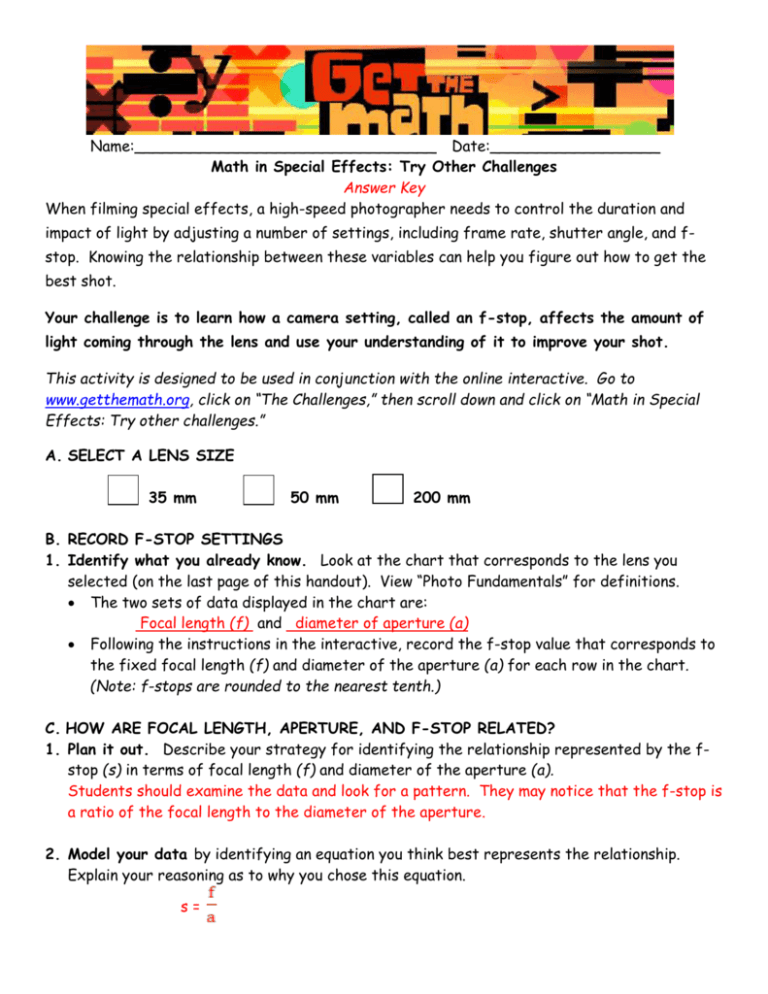
Name:________________________________ Date:__________________ Math in Special Effects: Try Other Challenges Answer Key When filming special effects, a high-speed photographer needs to control the duration and impact of light by adjusting a number of settings, including frame rate, shutter angle, and fstop. Knowing the relationship between these variables can help you figure out how to get the best shot. Your challenge is to learn how a camera setting, called an f-stop, affects the amount of light coming through the lens and use your understanding of it to improve your shot. This activity is designed to be used in conjunction with the online interactive. Go to www.getthemath.org, click on “The Challenges,” then scroll down and click on “Math in Special Effects: Try other challenges.” A. SELECT A LENS SIZE 35 mm 50 mm 200 mm B. RECORD F-STOP SETTINGS 1. Identify what you already know. Look at the chart that corresponds to the lens you selected (on the last page of this handout). View “Photo Fundamentals” for definitions. The two sets of data displayed in the chart are: Focal length (f) and diameter of aperture (a) Following the instructions in the interactive, record the f-stop value that corresponds to the fixed focal length (f) and diameter of the aperture (a) for each row in the chart. (Note: f-stops are rounded to the nearest tenth.) C. HOW ARE FOCAL LENGTH, APERTURE, AND F-STOP RELATED? 1. Plan it out. Describe your strategy for identifying the relationship represented by the fstop (s) in terms of focal length (f) and diameter of the aperture (a). Students should examine the data and look for a pattern. They may notice that the f-stop is a ratio of the focal length to the diameter of the aperture. 2. Model your data by identifying an equation you think best represents the relationship. Explain your reasoning as to why you chose this equation. s= Math in Special Effects: Try other challenges Answer Key 3. Solve for the variables using the equation you selected and your recorded data. Show all work below. Be sure to record the corresponding values in your chart to test out your prediction. (See charts for all solutions.) 4. Validate your answer: Is your equation a good representation of the relationship? If not, try looking for a pattern to determine how to find the matching f-stop(s) and try another equation. If so, explain how the aperture diameter and f-stop are related. There is an inverse relationship between f-stop and the diameter of aperture. D. HOW MUCH LIGHT PASSES THROUGH AT A GIVEN F-STOP? 1. Plan it out. Identify the formula you will use for calculating the area, A, of the aperture opening for each f-stop. 2. Solve by calculating A for each row in your chart. (Use = 3.14 and round to the nearest sq mm for 200mm lens or the nearest tenth for 50mm or 35mm lens.) Use the space below to show your work. Record your solutions in each row of the chart. (See charts for all solutions.) E. IDENTIFY THE RELATIONSHIP BETWEEN F-STOP (s) AND AREA OF APERTURE (A) 1. Plan it out. Describe your strategy for identifying the relationship between f-stop (s) and Area of aperture (A). Students should examine the data to look for a pattern. They may notice that there is a relationship between f-stops and light intensity (or area of the aperture). “Opening up” to the next lower f-stop (for instance, going from f/1.4 to f/1) lets in twice as much light by increasing the diameter of the opening by a factor of , or about 1.414. As diameter increases by a factor of , the area of the aperture, and therefore, light intensity, doubles. Conversely, “closing down” to each greater f-stop (for instance, going from f/2 to f/2.8) reduces the light intensity by half. 2. Model your data by identifying an equation you think best represents the relationship. Why did you choose this equation? A= 3. Solve for the constant, k, for each row. Show all work below. Be sure to record the values for (k) in your chart to test out your prediction. (Round to the nearest thousand.) (See charts for all solutions.) 2 Math in Special Effects: Try other challenges Answer Key 4. Validate your answer: Is your equation a good representation of the relationship? If not, try looking for a pattern to determine how to find the constant value (k) and try another equation. If so, explain how the f-stop and Area of the aperture are related. There is an inverse square relationship between f-stop (s) and the Area of aperture (A). F. USE YOUR UNDERSTANDING OF F-STOPS TO ADJUST THIS SHOT 1. The f-stop is currently set at f/5.6, but the shot is underexposed. If the shot requires a setting that is 8 times brighter, to what f-stop should you adjust to get more light? Open up 3 stops to f/2 2. If the shot requires a setting that is 1/4 as bright and the f-stop is currently set at f/5.6, to what f-stop should you adjust to get less light? Close down 2 stops to f/11 3. If the shot requires a setting that is 8 times brighter and the f-stop is currently set at f/16, to what f-stop should you adjust to get more light? Open up 3 stops to f/5.6 4. Explain your reasoning. If you were going to email a friend to explain your strategy for finding the correct f-stop for any shot, what would you tell them? There is a relationship between f-stops and light intensity (or area of the aperture). Opening up to the next lower f-stop lets in twice as much light by increasing the diameter of the opening by a factor of , or about 1.414. As diameter increases by a factor of , the area of the aperture, and therefore, light intensity, doubles. Conversely, closing down to each greater f-stop reduces the light intensity by half. 3 Math in Special Effects: Try other challenges Answer Key Photo Fundamentals Aperture An opening in the lens, or circular hole, that can vary in size. It is adjusted to increase or decrease the amount of light. Diameter of aperture (a) The physical size of the hole measured through its center point. Half of the diameter is the radius of the lens. Area of aperture (A) The measurement, in square mm, of the opening of the hole formed by the aperture. Focal length (f) The distance between the optical center of the lens (typically, where the aperture is located) and the image plane, when the lens is focused at infinity. Image plane The fixed area behind a camera lens – inside the camera – at which the sensor or film is located, and on which pictures are focused. f-stop (s) The camera setting that regulates how much light is allowed by changing the aperture size, which is the opening of the lens. Solutions for 35 mm lens focal length (f) diameter of aperture f-stop (s) Area of aperture (A) (in sq. mm to nearest tenth) Constant (k) (a) (round to nearest tenth) 35 35 1.0 961.6 1,000 35 25 1.4 490.6 1,000 35 17.5 2.0 240.4 1,000 35 12.5 2.8 122.7 1,000 35 8.8 4.0 60.8 1,000 35 6.3 5.6 31.2 1,000 35 4.4 8.0 15.2 1,000 35 mm lens (round to nearest thousand) 4 Math in Special Effects: Try other challenges Answer Key Solutions for 50 mm lens focal length (f) diameter of aperture f-stop (s) Area of aperture (A) (in sq. mm to nearest tenth) Constant (k) (a) (round to nearest tenth) 50 50 1.0 1,962.5 2,000 50 35.7 1.4 1,000.5 2,000 50 25 2.0 490.6 2,000 50 17.9 2.8 251.5 2,000 50 12.5 4.0 122.7 2,000 50 8.9 5.6 62.2 2,000 50 6.25 8.0 30.7 2,000 50 mm lens (round to nearest thousand) Solutions for 200 mm lens focal length (f) diameter of aperture f-stop (s) Area of aperture (A) (in sq. mm to nearest integer) Constant (k) (round to nearest thousand) (a) (round to nearest tenth) 200 200 1.0 31,400 31,000 200 142.9 1.4 16,030 31,000 200 100 2.0 7,850 31,000 200 71.4 2.8 4,002 31,000 200 50 4.0 1,963 31,000 200 35.7 5.6 1,000 31,000 200 25 8.0 491 31,000 200 mm lens 5


